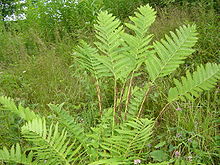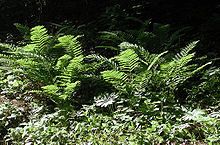| Claytosmunda Temporal range: Middle Triassic–Recent PreꞒ Ꞓ O S D C P T J K Pg N | |
|---|---|

| |
| Conservation status | |
 Secure (NatureServe) | |
| Scientific classification | |
| Kingdom: | Plantae |
| Clade: | Tracheophytes |
| Division: | Polypodiophyta |
| Class: | Polypodiopsida |
| Order: | Osmundales |
| Family: | Osmundaceae |
| Section: | Claytosmunda (Y.Yatabe, N.Murak. & K.Iwats.) Metzgar & Rouhan |
| Species: | C. claytoniana |
| Binomial name | |
| Claytosmunda claytoniana (L.) Metzgar & Rouhan | |
| Synonyms | |
|
(genus)
(species)
| |
Claytosmunda is a genus of fern. It has only one extant species, Claytosmunda claytoniana (synonym Osmunda claytoniana), the interrupted fern, native to Eastern Asia, Eastern United States, and Eastern Canada.
The specific epithet is named after the English-born Virginian botanist John Clayton. "Interrupted" describes the gap in middle of the blade left by the fertile portions after they wither and eventually fall off.
The plant is known from fossils to have grown in Europe, showing a previous circumboreal distribution. Fragmentary foliage resembling Claytosmunda has been found in the fossil record as far back as the Triassic.
Description


Claytosmunda claytoniana fronds are bipinnate, 40–100 cm (16–39 in) tall and 20–30 cm (8–12 in) broad, the blade formed of alternate segments forming an arching blade tightening to a pointed end. The lower end is also slightly thinner than the rest of the frond because the first segments are shorter. Three to seven short, cinnamon-colored fertile segments are inserted in the middle of the length, giving the plant its name.
In their absence, the plant in all its stages appears similar to Osmundastrum cinnamomeum (cinnamon fern). The base of the segments distinguishes the two species: where O. cinnamomeum has typical felt-like hairs, the few hairs present on C. claytoniana are extremely short, usually requiring a magnifying glass to see well.
Like other species in the family Osmundaceae, it grows a very large rhizome, with persistent stipe bases from previous years. It forms small, dense colonies, spreading locally through its rhizome, and often forming fairy rings.
Taxonomy
The species was first described by Carl Linnaeus in 1753, as Osmunda claytoniana. In 2005, it was recognized as being somewhat different from other species in the genus by being placed in a separate subgenus, Osmunda subgenus Claytosmunda. In 2016, the subgenus was raised to a new genus, Claytosmunda, as part of the Pteridophyte Phylogeny Group classification (PPG I). The change of genus is recognized in some taxonomic databases. Others place the species in the genus Osmundastrum. The oldest known species of Claytosmunda is C. beardmorensis, from the Middle Triassic of Antarctica. Claytosmunda when considering fossils is paraphyletic, as some of the fossils are likely to be more closely related to modern Osmunda and Plenasium than they are to the modern C. claytoniana.
Extinct species
After
- †C. beardmorensis (J.M.Schopf, 1978) (Middle Triassic: East Antarctica).
- †C. chengii Blomfleur et al. 2017 (Middle Jurassic: Liaoning, China).
- †C. johnstonii (Tidwell, Munzing & M.R.Banks, 1991) (?Early Jurassic: Tasmania, Australia).
- †C. embreii (Stockey & S.Y.Sm., 2000) (Early Cretaceous: California, USA).
- †C. liaoningensis (Wu Zhang & Shao-Lin Zheng, 1991) (Middle Jurassic: Liaoning, China).
- †C. nathorstii (C.N.Mill., 1967) (Palaeogene: Svalbard).
- †C. plumites (N.Tian & Y.D.Wang 2014) (Middle Jurassic: Liaoning, China).
- †C. preosmunda (Y.M.Cheng, Yu F.Wang & C.S.Li, 2007) (Middle Jurassic: Liaoning, China).
- †C. sinica (Y.M.Cheng & C.S.Li, 2007) (Middle Jurassic: Liaoning, China).
- †C. tekelili (E.I.Vera, 2012) (Early Cretaceous: West Antarctica).
- †C. wangii (N.Tian & Y.D.Wang, 2014) (Middle Jurassic: Liaoning, China).
- †C. wehrii (C.N.Mill., 1982) (Miocene: Washington, USA).
- †C. zhangiana Tian et al, 2021. (Middle Jurassic, Liaoning, China)
Distribution
North America
In eastern North America it occurs in: the Great Lakes region; eastern Canada – in southern Manitoba, Ontario, Quebec (north to tree line); and east to Newfoundland; eastern United States – upper New England south through the Appalachian Mountains and Atlantic seaboard, into the Southeastern United States in Georgia and Alabama; and west across the Southern United States to Mississippi River, and back up the Mississippi embayment through the Midwestern United States to the Great Lakes.
Asia
In eastern Asia, the fern is found in the subtropical and temperate Asia in: the Eastern Himalaya, South Central China and Eastern China, Taiwan, the Korean Peninsula, the Ryukyu Islands, and Japan.
Ecology
Claytosmunda claytoniana is found in humid zones, mostly in forests, but also in more open habitats and biomes, although rarely in bogs. The interrupted fern is often found alongside ostrich, cinnamon, and sensitive ferns.
Hybrids
Osmunda × ruggii, is a hybrid between C. claytoniana and O. spectabilis (American royal fern). The hybrid is considered important because it suggests a closer genetic relationship between C. claytoniana and O. spectabilis than between C. claytoniana and O. cinnamomeum (a fact which has led to moving O. cinnamomeum out of Osmunda and into its own genus Osmundastrum). Osmunda × ruggii is sterile and is known from only about two natural populations, despite the many areas in which both C. claytoniana and O. spectabilis are found.
Uses
Medicinal
The Iroquois used the plant as treatment for blood disorders and venereal diseases.
References
- "NatureServe Explorer 2.0 - Osmunda claytoniana Interrupted Fern". explorer.natureserve.org. Retrieved 9 October 2020.
- ^ PPG I (2016). "A community-derived classification for extant lycophytes and ferns". Journal of Systematics and Evolution. 54 (6): 563–603. doi:10.1111/jse.12229. S2CID 39980610.
- ^ "Claytosmunda claytoniana (L.) Metzgar & Rouhan". Plants of the World Online. Royal Botanic Gardens, Kew. Retrieved 2019-08-08.
- Fernald's "Gray's Manual of Botany" (1950)
- University of Wisconsin-Madison Arboretum, Interrupted fern profile Archived 2013-09-27 at the Wayback Machine
- "Osmunda claytoniana L." The International Plant Names Index. Retrieved 2019-08-08.
- Hassler, M. (November 2018). "Species Details: Claytosmunda claytoniana (L.) Metzgar & Rouhan". World Ferns: Checklist of Ferns and Lycophytes of the World. The Species 2000 & ITIS Catalogue of Life. Retrieved 2019-08-08.
- ^ Bomfleur, Benjamin; Grimm, Guido W.; McLoughlin, Stephen (2017-07-11). "The fossil Osmundales (Royal Ferns)—a phylogenetic network analysis, revised taxonomy, and evolutionary classification of anatomically preserved trunks and rhizomes". PeerJ. 5: e3433. doi:10.7717/peerj.3433. ISSN 2167-8359. PMC 5508817. PMID 28713650.
- Tian, Ning; Wang, Yong-Dong; Jiang, Zi-Kun (July 2021). "A new permineralized osmundaceous rhizome with fungal remains from the Jurassic of western Liaoning, NE China". Review of Palaeobotany and Palynology. 290: 104414. Bibcode:2021RPaPa.29004414T. doi:10.1016/j.revpalbo.2021.104414. S2CID 233549860.
- "4. Osmunda ruggii R. M. Tryon".
- Univ. Mich.-Dearborn College of Arts, Sciences, and Letters: Native American Ethnobotany: Osmunda species (scroll for O. claytoniana) . accessed 12.1.2011
- Flora of North America: Osmunda claytoniana RangeMap:
- Flora of Taiwan: Osmunda claytoniana
- Lamoureux, Gisèle and al. (1993). Fougères, prêles et lycopodes. Fleurbec. ISBN 978-2-920174-13-9.
- Phipps, C. J., Taylor, T. N., Taylor, E. L., Cuneo, N. R., Boucher, L. D., and Yao, X. (1998). Osmunda (Osmundaceae) from the Triassic of Antarctica: An example of evolutionary stasis. American Journal of Botany, 85: 888–895
| Taxon identifiers | |
|---|---|
| Claytosmunda | |
| Claytosmunda claytoniana | |
| Osmunda claytoniana |
|
| Osmunda subg. Claytosmunda | |
- NatureServe secure species
- Osmundales
- Ferns of the Americas
- Ferns of Asia
- Flora of China
- Flora of Japan
- Flora of Korea
- Flora of Taiwan
- Flora of the Northeastern United States
- Flora of the North-Central United States
- Flora of the Southeastern United States
- Flora of Eastern Canada
- Flora of Manitoba
- Edible plants
- Plants used in traditional Native American medicine
- Monotypic fern genera